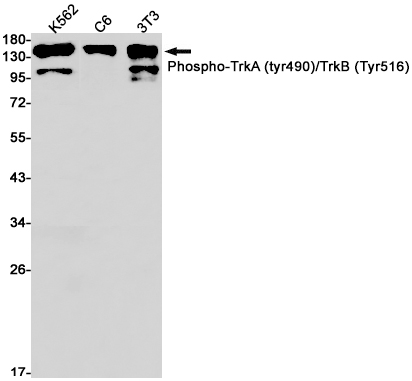
| WB | 咨询技术 | Human,Mouse,Rat |
| IF | 咨询技术 | Human,Mouse,Rat |
| IHC | 咨询技术 | Human,Mouse,Rat |
| ICC | 技术咨询 | Human,Mouse,Rat |
| FCM | 咨询技术 | Human,Mouse,Rat |
| Elisa | 咨询技术 | Human,Mouse,Rat |
| Aliases | NTRK2; TRKB; BDNF/NT-3 growth factors receptor; GP145-TrkB; Trk-B; Neurotrophic tyrosine kinase receptor type 2; TrkB tyrosine kinase; Tropomyosin-related kinase B |
| Entrez GeneID | 4915 |
| WB Predicted band size | Calculated MW: 92 kDa; Observed MW: 140 kDa |
| Host/Isotype | Rabbit IgG |
| Antibody Type | Primary antibody |
| Storage | Store at 4°C short term. Aliquot and store at -20°C long term. Avoid freeze/thaw cycles. |
| Species Reactivity | Human,Mouse,Rat |
| Immunogen | A synthetic phosphopeptide corresponding to residues surrounding Tyr516 of human TrkB |
| Formulation | Purified antibody in TBS with 0.05% sodium azide,0.05%BSA and 50% glycerol. |
+ +
以下是关于Phospho-TrkA/B (Tyr490/Tyr516)抗体的3篇参考文献,涵盖其在不同研究中的应用及机制:
1. **文献名称**:*Tyrosine phosphorylation of TrkA receptors triggered by NGF requires the TrkA activation loop*
**作者**:Cunningham ME, et al.
**摘要**:该研究通过使用Phospho-TrkA (Tyr490)抗体,揭示了神经生长因子(NGF)诱导的TrkA受体激活依赖于其酪氨酸磷酸化位点(如Tyr490),并证明该位点对下游MAPK信号通路的激活至关重要。
2. **文献名称**:*Phosphorylation of TrkB receptors regulates neuronal survival and differentiation via distinct signaling pathways*
**作者**:Huang EJ, et al.
**摘要**:文章利用Phospho-TrkB (Tyr516)抗体,证明脑源性神经营养因子(BDNF)通过TrkB受体的Tyr516磷酸化激活PI3K/Akt通路,进而促进神经元存活,而其他位点(如Tyr816)则主要调控分化相关信号。
3. **文献名称**:*Targeting Trk receptor signaling in cancer resistance*
**作者**:Drilon A, et al.
**摘要**:该研究通过检测肿瘤模型中Phospho-TrkA/B的激活状态(使用Tyr490/Tyr516抗体),发现Trk受体异常磷酸化与靶向治疗耐药性相关,为开发Trk抑制剂提供了实验依据。
以上文献均通过Phospho-TrkA/B抗体验证了受体激活状态与下游功能的关联,适用于神经生物学和癌症研究领域。
Phospho-TrkA/B (Tyr490/Tyr516) antibodies are essential tools for studying the activation of tropomyosin receptor kinase (Trk) family receptors, specifically TrkA and TrkB. These receptors play critical roles in neuronal survival, differentiation, and synaptic plasticity by binding neurotrophins like nerve growth factor (NGF) and brain-derived neurotrophic factor (BDNF). Upon ligand binding, Trk receptors dimerize and undergo autophosphorylation at specific tyrosine residues, initiating downstream signaling cascades. The phosphorylation of Tyr490 in TrkA and Tyr516 in TrkB serves as a key activation marker, enabling recruitment of adaptor proteins (e.g., Shc, PLC-γ) that activate pathways such as MAPK/ERK, PI3K/Akt, and PKC.
Phospho-specific antibodies targeting these sites allow researchers to detect and quantify receptor activation in experimental models. They are widely used in Western blotting, immunohistochemistry, and immunofluorescence to investigate Trk signaling dynamics in physiological contexts (e.g., neural development) or pathological conditions, including neurodegenerative diseases, pain disorders, and cancers. For instance, aberrant Trk activation is linked to tumor progression, making these antibodies valuable in cancer research and therapeutic development (e.g., evaluating Trk inhibitor efficacy).
When using these antibodies, proper controls (e.g., non-phosphorylated Trk or phosphorylation-blocking peptides) are critical to ensure specificity. Their applications extend to drug screening, mechanistic studies, and biomarker validation, underscoring their importance in both basic and translational neurobiology research.
×